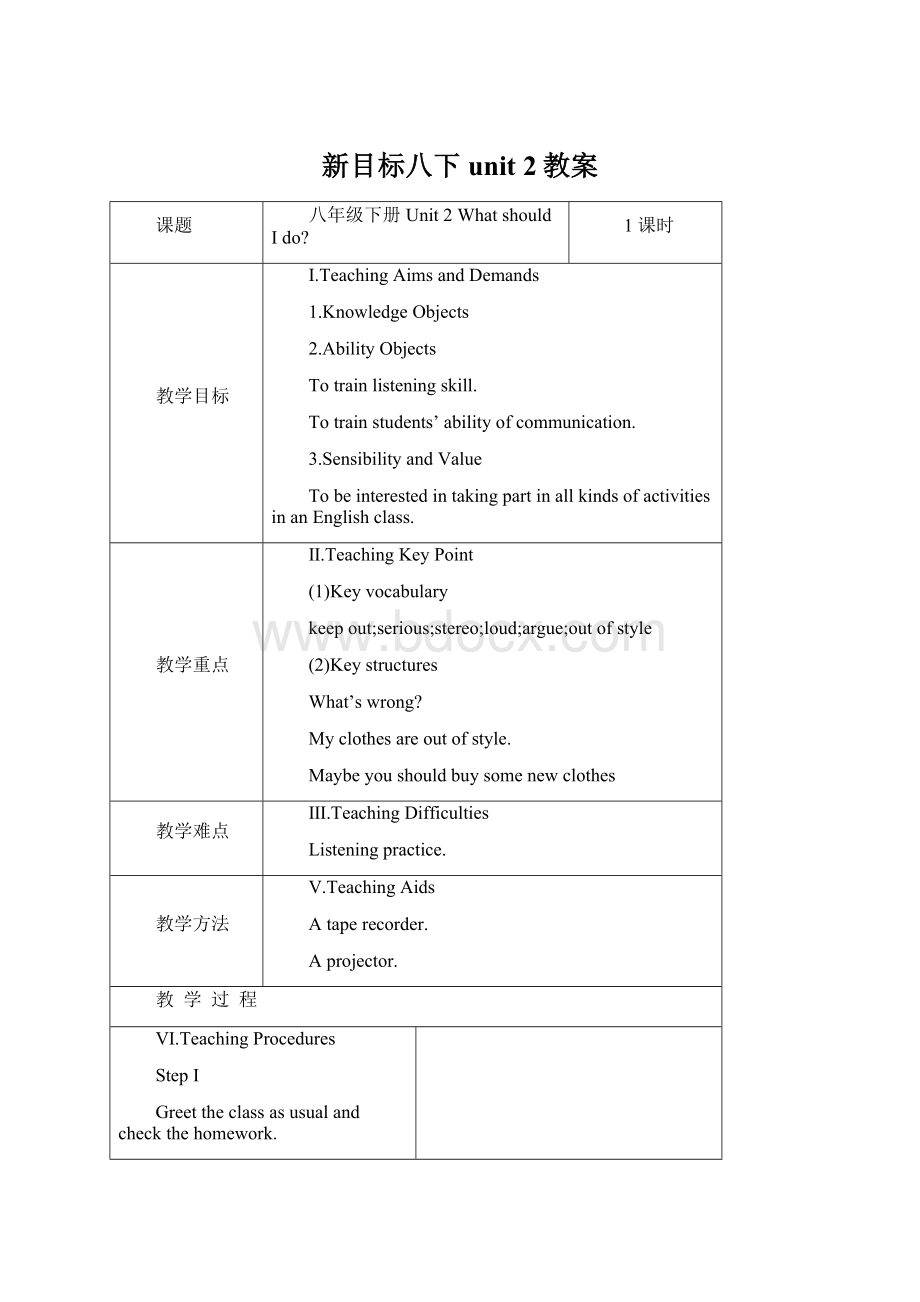新目标八下unit 2教案.docx
《新目标八下unit 2教案.docx》由会员分享,可在线阅读,更多相关《新目标八下unit 2教案.docx(23页珍藏版)》请在冰豆网上搜索。

新目标八下unit2教案
课题
八年级下册Unit2WhatshouldIdo?
1课时
教学目标
Ⅰ.TeachingAimsandDemands
1.KnowledgeObjects
2.AbilityObjects
Totrainlisteningskill.
Totrainstudents’abilityofcommunication.
3.SensibilityandValue
TobeinterestedintakingpartinallkindsofactivitiesinanEnglishclass.
教学重点
Ⅱ.TeachingKeyPoint
(1)Keyvocabulary
keepout;serious;stereo;loud;argue;outofstyle
(2)Keystructures
What’swrong?
Myclothesareoutofstyle.
Maybeyoushouldbuysomenewclothes
教学难点
Ⅲ.TeachingDifficulties
Listeningpractice.
教学方法
Ⅴ.TeachingAids
Ataperecorder.
Aprojector.
教学过程
Ⅵ.TeachingProcedures
StepⅠ
Greettheclassasusualandcheckthehomework.
StepⅡSectionA
Showachartonthescreen.
Problem
IwanttobuyanewguitarbutIdon’thaveenoughmoney.
Advice
1.Waituntilnextyear.
2.Don’tbuyaguitar.
3.Borrowone.
4.Buyausedguitar.
5.Getapart-timejob.
Andtellstudentswhatmyproblemis.Askstudentstogiveadvice.
Thenwritethewordscould,shouldandshouldn’tontheboard.Readtheproblemtotheclassagainandhelptheclassgiveadviceusingthewordscould,shouldandshouldn’t.Repeateachpieceofadvicetohelpstudentsunderstandit.
Tellstudentsinthisunitwe’regoingtotalkaboutproblemspeoplehaveandlearnhowtogivethesepeopleadvice—totellpeoplewhatwethinktheyshoulddo.
StepⅢ
Showthenewwordsonthescreen.Readthenewwordsandaskstudentstorepeat.Makesurethatstudentsunderstandthemeaningsofthenewwords.
StepⅣ1a
NowpleaseopenyourbooksatPage10.Lookatactivity1aplease.
Pointtotheproblemsandaskfivestudentstoreadtheproblemstotheclass.
Sa:
Myparentswantmetostayathomeeverynight.
Sb:
Mybrotherplayshisstereotooloud.
Sc:
Idon’thaveenoughmoney.
Sd:
Iarguedwithmybestfriend.
Se:
Myclothesareoutofstyle.
Readeachsentenceagainandaskstudentstorepeatit.Askstudentstoexplainintheirownwordswhateachsentencemeans.Theycanpointtopartsofthepicture,useactions,simpledrawingsontheboardandsimplesentences.
Thenpointouttheheadingsintheboxtotheclass.Tellstudentsseriousproblemisaverybadproblem,averybigproblem.
AskstudentstowritetheproblemsintheSeriousor Notseriouscolumns.
Nowtalkabouttheanswerswiththeclass.
(Thisactivityintroducessomekeyvocabulary.)
StepⅤ1b
Inthisactivityfirstaskdifferentstudentstosaywhattheyseeineachpicture.
Thenaskstudentstolistentotheconversation.Inthechartcircletheproblemsthattheyhearthegirlstalkingabout.
Playtherecordingforthefirsttime.Studentsonlylisten.Andthenplayitasecondtime.Thistimestudentscircletheproblemstheyhear.
Correcttheanswers.
Answers
Thefollowingproblemsshouldbecircled:
Myparentswantmetostayathomeeverynight.
Mybrotherplayshisstereotooloud.
Idon’thaveenoughmoney.
Myclothesareoutofstyle.
Tapescript
Girl1:
Youlookunhappy.What’swrong?
Girl2:
Oh...myclothesareoutofstyle.Idon’tlookcool.
Girl1:
Well,maybeyoushouldbuysomenewclothes.
Girl2:
Yes,butIdon’thaveenoughmoney.
Girl1:
Huh.Maybeyoucouldgetapart-timejobintheevenings.
Girl2:
Ican’t,becausemyparentswantmetostayathomeeverynight.Iarguedwiththemaboutit.
Girl1:
Well,youshouldn’targuewithyourparents.Youshouldtalkaboutyourproblems.
Girl2:
Andguesswhatelseiswrong?
Girl1:
What?
Girl2:
Mybrotherplayshisstereotooloud!
Ican’tgotosleep.
(Thisactivitygivesstudentspracticeinunderstandingthetargetlanguageinspokenconversation.)
StepⅥ1cPairwork
Firstasktwostudentstoreadthesampledialogue.
Sa:
What’swrong?
Sb:
Myclothesareoutofstyle.
Sa:
Maybeyoushouldbuysomenewclothes.
Thensay,Makeconversationslikethisabouttheproblemsinactivity1a.
Asstudentstalk,movearoundtheclassroomcheckingtheirwork.Offerlanguagesupportasneeded.
Intheendaskseveralpairsofstudentstosaytheirconversationstotheclass.
Givethemlittlepresentsiftheydotheirworkwell.
(Thisactivityprovidesguidedoralpracticeusingthetargetlanguage.)
StepⅦSummary
Thisclasswe’velearnedsomekeyvocabulary.Andwe’velearnthowtogivesomebodyadviceifheorshehassomeproblems.Ifyouareinterestedinjoiningallkindsofactivitiesinclass,you’llmakegreatprogress.
StepⅧHomework
Pleaseaskyourparentsorfriendswhatproblemstheyhaveinordertoseeifyoucangivethemsomegoodadvice.
课文重点、难点、考点详解
1.Idon'thaveenoughmoney.
enough:
adj/adv.充足的、充分的;足够地、十分。
修饰名词,放在他所修饰的名词之前,修饰形容词或副词时,只能放在所修饰的词之后;作代词,充分、足够。
如:
Ihaveenoughtimetodoit.
Thebookisexpensiveenough.
Leavethepotatoesifyouhadenough.
注意:
be(not)……enoughtodo有(没有)足够的….去做…..,这时可以同so….that…或too…to….结构相互转换。
如:
Thegirlisnotoldenoughtogotoschool.
=Thegirlistooyoungtogotoschool.
=Thegirlissoyoungthatshecan’tgotoschool.
【典型例题】
转换句型:
Theboxistooheavytocarryitforme.
2.Iarguedwithmybestfriend.
arguewithsb.意为"与......争吵,争论".如:
Heoftenargueswithhisclassmates.
注意:
argueabout/onsth.争辩某事。
3.Myclothesareoutofstyle.
beoutofstyle/fashion表示"过时""不合乎时尚"
反义词是"beinstyle/fashion"表示"合乎时尚、流行的"。
如:
Heisalwaysinfashion.
Thesofaisoutofstyle,andIdon'tlikeit.
4.Maybeyoushouldcallhimup.
(1)maybe是副词,用来表示推测,译为"也许,或许,大概"。
如:
Maybeyouareright.
Maybetheywillgooutforawalk.
注意:
maybe不同于maybe。
maybe是一个词,是副词,maybe是情态动词may加上动词原形be,意为"或许",后接形容词、名词、代词等。
如:
Itmaybetrue.
Hemaybethemanwearelookingfor.
(2)callsbup.打电话给某人。
如:
IcalledupZhangHongateighto'clock.
原句中him为代词,所以放在call和up之间,不能说成calluphim。
如:
I'llcallherupthisafternoon.
Couldyouaskhimtocallme,please.在这个句子中,省略up。
注意:
在动副结构的短语中,代词一定放在动副之间。
5.Idon'twanttosurprisehim.
在这句话中surprise是个行为动词,可以说成"surprisesb.",表示"使......惊讶"。
如:
Thenewssurprisesusgreatly.
注意:
surprisedadj.惊讶的;surprisingadj.令人惊讶的。
如:
I'msurprisedtohearthenews.
It'sasurprisinggift,andIloveit.
6.No,hedoesn'thaveanymoney,either.
either的用法:
用作副词,用在否定句或否定词组后加强语气,表示"也","而且",常用逗号隔开。
如:
Hedoesn'tlikesinging,andhedoesn'tlikedancing,either.
either用作代词时,常表示"两者之中任何一个",常与短语连用或用作宾语。
如:
Eitherofthemwillagreewithyou.
Idon'tlikeeitherofthebooks.
注意:
区别either,tooandalso.
also也,用在肯定句中,位于be动词、助动词和情态动词之后,行为动词前。
如:
Wealsolikeplayingfootball.
too也,用在陈述句和疑问句句末,常用逗号隔开。
如:
Hehasalotofpenpals,too.
AreyouAmerica,too?
7.Ineedtogetsomemoneytopayforsummercamp.
(1)need是个情态动词,也可以是行为动词。
▲当它是情态动词时,后边直接加行为动词,表示"需要",但need作情态动词时一般不用于肯定句。
它一般用于否定句和疑问句中,例如:
①Youneednotmeethim.
②NeedIrepeatit?
对上一句的简略回答为:
Yes,youneed./No,youneedn't.
▲此外情态动词must提问时,否定回答时为No,...needn't/don’thaveto。
Musthefinishthehomeworknow?
Yes,hemust.No,heneedn't.
当need作行为动词时,同其他行为动词一样对待,need后加不定式为"needtodo"。
例如:
Ineedtofinishthework.
变为疑问句时,不能像它作情态动词时直接提前,而要加助动词do/does/did等,例如:
Heneedstowritemanywords.
改成一般问句:
Doesheneedtowritemanywords?
Yes,hedoes.No,hedoesn't.
(2)(sb.)pay(money)forsth.为......而付款
(sb.)spend(money)onsth在......上花多少钱
(sth.)costsb.(money)什么东西值多少钱
这三个短语都是表示付款。
但pay,spend指的是"人",主语为人,而cost指的是"物",主语为"物"。
例如说他昨天花10元买了一本书。
用以上三个短语分别为:
①Hepaid10yuanforthebookyesterday.
②Hespent10yuanonthebookyesterday.
③Thebookcosthim10yuanyesterday.
注意以上三个动词的动词过去式为:
pay---paidspend----spentcost----cost
板书设计
1.Youshouldcallhimup.
2.Idon’twanttosurprisehim.
3.Iarguedwithmybestfriend.
4.Hedoesn’thaveanymoney,either.
教学反思
课题
SectionB
2课时
教学目标
I.Teachingaimsanddemands:
Studentspracticethetargetlanguagebyreadingandwriting.
教学重点
II.Teachingkeypoints:
A.Vocabulary
except,upset,findout,dowrong,whattodo,lonely,argue
B.Targetlanguage
Everyoneelseinmyclasswasinvitedexceptme.
I’mveryupsetanddon’tknowwhattodo.
Ijustfoundoutthatmyfriendswereplanningabirthdaypartyformybestfriend.
教学难点
III.TeachingDifficultPoints
Studentslearnhowtogiveotherstudentsadvice
教学方法
III.Teachingmethods:
Pairwork,GroupworkandControl-writing.
教学过程
Step1Leading-in
Task1Whatproblemsdoyouhave?
Task2Pairwork:
A:
Ifailedthetestagain.
B:
Youshouldstudyhard.
Step2Listening
Task1Listenandfindoutifitistrueorfalse
1.Tomdoesn’tneedanyhelp.
2.Everyoneelsewasinvitedexcepthim.
3.Hewasupsetanddidn’tknowwhattodo.
4.Heisreallyverypopularatschool.
Step3Readingandwriting
Task1Askthestudentstoreadtheletterandunderlinetheproblemontheirown.
Correcttheanswers.
Task2就这封信,在组内进行提问,然后给大家介绍一下解决的问题和未解决的问题。
以问题探究的形式呈现知识点
Task3Askstudentstosaysomeoftheadvicetheymightgive.Writethekeywordsontheboard.
Task4Askthestudentstowritethelettersontheirown.
Task5Asksomestudentstoreadtheirletterstotheclass.
Step4Writingonyourown.
1.Sally咨询室,writetome,writetoSally.
2.AskonestudenttowriteontheBB
3.帮助解决问题,Sally招募小助手。
Step5Homework
1.Reviewthevocabulary.
2.Finishoffthewritingexercises.
课文重点、难点、考点详解
1、Shealsosaysthatthesechildrenmayfindithardtothinkforthemselveswhentheyareolder.
find+it+adj.+(forsb.)todosth.发现做某事(对某人来说)是……。
如:
Ifinditeasyformetofinishtheworkinanhour.
2、Thetiredchildrendon’tgethomeuntil7p.m.
until知道…为止,如:
Iwillwaitforhimuntilhecomesback.
not…until,直到…..才。
如:
hedidn’tgotobeduntilhisfathercameback.
3、Idon’tknowwhattodo.
whattodo是疑问句加不定式结构,在句中做宾语,这种结构经常放在tell,show,teach,forget,findout等词后作宾语。
如:
Iforgotwhattodonext.
Idon’tknowhowtodoitnext.
Theteachershoweduswhattodowithit.
4.ask(sb.)forsth.向某人寻求某物;要……